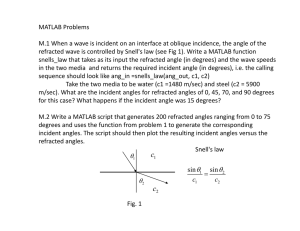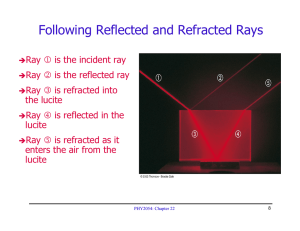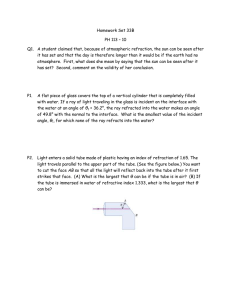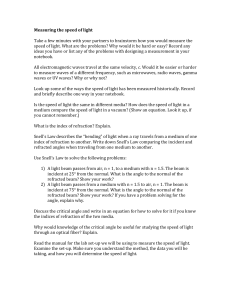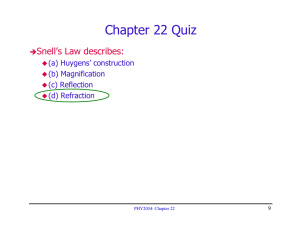LECTURE 19: SEISMIC WAVE PROPAGATION Huygen`s principle
advertisement
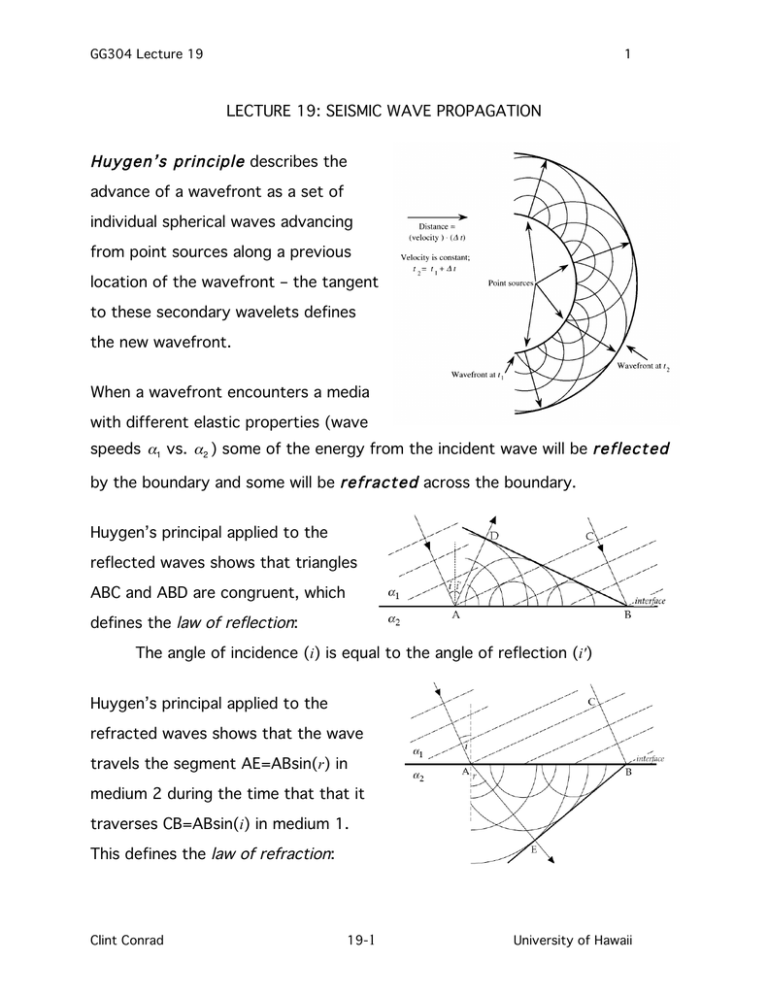
GG304 Lecture 19 1 LECTURE 19: SEISMIC WAVE PROPAGATION Huygen’s principle describes the advance of a wavefront as a set of individual spherical waves advancing from point sources along a previous location of the wavefront – the tangent to these secondary wavelets defines the new wavefront. When a wavefront encounters a media with different elastic properties (wave speeds α1 vs. α 2 ) some of the energy from the incident wave will be reflected by the boundary and some will be refracted across the boundary. Huygen’s principal applied to the reflected waves shows that triangles ABC and ABD are congruent, which defines the law of reflection: The angle of incidence (i) is equal to the angle of reflection (i') Huygen’s principal applied to the refracted waves shows that the wave travels the segment AE=ABsin(r) in medium 2 during the time that that it traverses CB=ABsin(i) in medium 1. This defines the law of refraction: Clint Conrad 19-1 University of Hawaii GG304 Lecture 19 sini α1 = sinr α 2 2 which is known as Snell’s law. Huygen’s principle allows seismic waves to bend around the edges of an object. This is known as diffraction . Fermat’s principle states that seismic rays follow the path that gives the shortest travel h i i' times between points. For the intersection of a ray path with an interface at position x, these r travel times can be written as: " 2% Reflected waves: t = $ h 2 + x 2 + h 2 + (d − x ) ' α1 # & 2 Refracted waves: t = h 2 + x 2 α1 + h 2 + (d − x ) α 2 x h d-x Minimizing these travel times as a function of x yields the laws of reflection and refractions, as above. An incident P-wave deflects an interface in directions both parallel to and perpendicular to the propagation direction in the second medium, generating refracted P- and SV-waves, respectively, as well as reflected counterparts. Fermat’s principle allows us to calculate their incident angles: sini p sini s sinrp sinrs = = = α1 β1 α2 β2 Similarly, an incident SV-wave will induce reflected and refracted SV- and Pwaves. However, a SH-wave does not deform the interface in the vertical direction, and thus produces only reflected and refracted SH-waves. Clint Conrad 19-2 University of Hawaii GG304 Lecture 19 3 If α 2 > α1 , then the refracted angle r will be greater than the incident angle i. If the incident angle is equal to a critical angle ic, then r=90°, and the refracted ray travels along the interface. The critical angle can α be determined as: sini c = 1 α2 For incident angles > ic, energy is not lost to refraction, so reflections with large amplitudes are recorded for distances d > 2h0 sini c (the critical distance). A travel time diagram shows the first arrivals of seismic energy as a function of distance away from a seismic source. For a slow layer over a faster halfspace: Close to the source, the first arrival will be a direct P-wave traveling through the top layer. Farther from the source, Pwaves refracted through the faster lower layer will arrive first. From this diagram, we can determine: V0 and V1 are determined from the inverse of slopes of the travel time curves. The critical angle is then: i c = sin−1 (V0 V1) The intercept T01 represents the time for the P-wave to travel through the upper layer: T 01 = 2h0 cosi c V0 Clint Conrad which allows us to estimate the thickness h0. 19-3 University of Hawaii
